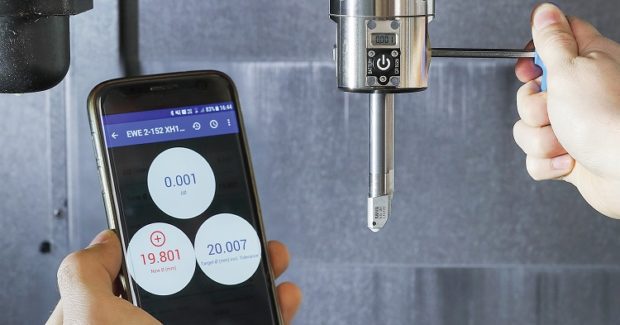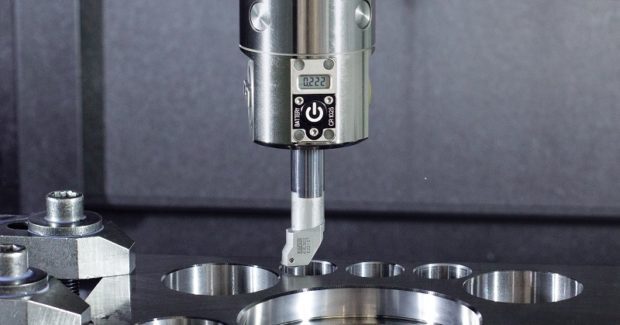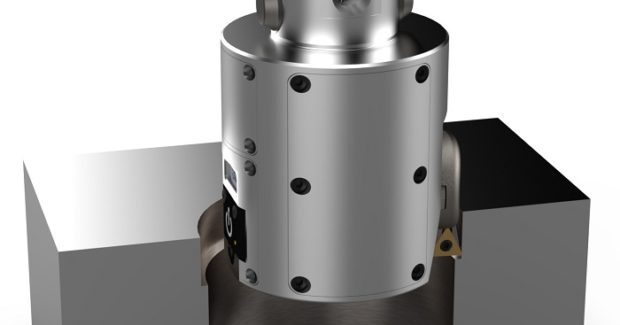Next Steps in the Digitalization of Tooling and Its Impact on Operators
Digital tools are already here in the form of DROs and one-way communications to mobile devices, but that’s only the beginning. Get ready for some exciting breakthroughs in automation that promise higher productivity, increased safety, greater throughput and less scrap.
Posted: June 28, 2019
The digital manufacturing revolution is in full swing. We all see it, taking shape in the form of cloud-connected machine controls, robotics, remote monitoring and automation, just to name a few. It’s fair to say tooling is behind other areas of metalworking equipment in terms of impact and high technology – analog is still widely the name of the tooling game – but there have been signs of digital progress in recent years. Breakthroughs are just over the horizon. And while tools are a physically small piece of the manufacturing chain, their digitalization provides major opportunities for production improvements. Boring heads, like our EWE product line, for instance, include digital readouts that, with the help of solid-state magnetic scales, display the actual diameter of the tool instead of hard-to-read Vernier markings. These heads not only make adjustments in the machine much simpler but also clearly reveal any backlash at the adjustment screw. They can also pair with a mobile app via Bluetooth® so that adjustments can be tracked and saved; reduction of human error, speedier adjustments, and readily available wear and setup histories are just a few of the benefits of this arrangement.
A few short years ago, digital fine-boring tools like the EWE would be thought of as “pie in the sky,” but now they’re being applied every day. This is just the first step in the digitalization of tooling. The next phase is closing the automation loop. We are currently developing the EWA fine boring head, available by the end of next year. A motor built into the head moves the cutting edge to the proper diameter automatically via remote Bluetooth commands, eliminating the time and risk associated with the machine operator manually adjusting the boring head by hand. The implications of automated fine boring operations are huge. In addition to making lights-out boring a real possibility, this will add versatility and speed to boring operations. With the help of a machine-integrated touch probe or bore gage, the same head can be adjusted to compensate for cutting insert wear and eliminate the manual rework of undersized bores. Similarly, the head can be automatically adjusted to different hole sizes, reducing the need to have multiple boring tools set at different diameters in the machine’s tool magazine.
Soon after these capabilities are understood and adopted, what comes next will feel natural and have an even more profound impact: communication directly with the machine control. Tool diameter adjustments will be part of the programming process, so that human intervention is not required when a new hole is ready for finishing. The next phase will be the integration of sensors like accelerometers into the tools and/or fixtures. We’ve already conducted tests with vibration sensors in tools, and the results are promising. This will have dramatic effects on diagnostics and error prevention both before and during machining. Simple air cutting will be able to reveal imbalances and resonant frequencies that will help validate if speed is within the proper range or a damping system will be needed. While in the cut, these sensors can recognize unsecured workpieces, as well as damaged or worn cutting edges, and record overall cutting quality for finer tuning of machining parameters.
These impending innovations will bring us into a brave new world. But it begs the question, what impact will there be on operators? The natural reaction is to think that jobs will be eliminated. I’m here to tell you that’s not the case. These innovations will help operators do their job better. They’ll be able to do more with the mobile devices they use every day; they’ll be freed up to perform other tasks like preparing new workpieces or tool setups. Skills and know-how won’t become obsolete. Instead, they’ll adjust to recognize different queues, fill information gaps, and make different adjustments on the fly. And it will all be done more safely, since there is less reaching in and out of the machine.
To recap, digital tools are already here in the form of DROs and one-way communications to mobile devices. In a short time, we’ll see heads that can be adjusted remotely thanks to integrated motors. Not too much further down the road, we’ll be able to program controls to adjust heads to new cuts. And once sensors are introduced, the machine will be able to adapt to changes in the environment, stock or tool changes.
Operators will not be out of work, rather they’ll adapt – and fairly easily – to be more productive and safer all the while. Shops will enjoy more throughput and less scrap. It’s all just a matter of (not too much) time. Get prepared and get excited.

















